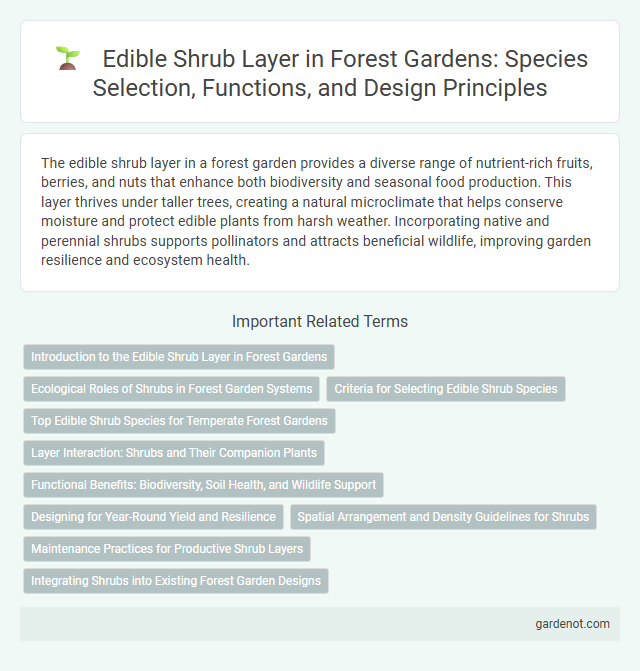The edible shrub layer in a forest garden provides a diverse range of nutrient-rich fruits, berries, and nuts that enhance both biodiversity and seasonal food production. This layer thrives under taller trees, creating a natural microclimate that helps conserve moisture and protect edible plants from harsh weather. Incorporating native and perennial shrubs supports pollinators and attracts beneficial wildlife, improving garden resilience and ecosystem health.
Introduction to the Edible Shrub Layer in Forest Gardens
The edible shrub layer in forest gardens comprises nutrient-rich, low-maintenance plants such as currants, gooseberries, and sea buckthorn that thrive under taller trees. These shrubs enhance biodiversity, improve soil health through nitrogen fixation, and provide a continuous harvest of fruits and berries. Integrating this layer supports sustainable food production while promoting pollinator habitats and natural pest control.
Ecological Roles of Shrubs in Forest Garden Systems
Shrubs in the edible shrub layer of forest gardens play a crucial role in supporting biodiversity by providing habitat and food sources for pollinators, birds, and beneficial insects. They contribute to soil health through nitrogen fixation and leaf litter decomposition, enhancing nutrient cycling within the ecosystem. Furthermore, edible shrubs act as living mulch, reducing soil erosion and maintaining moisture levels essential for the sustainability of forest garden systems.
Criteria for Selecting Edible Shrub Species
Selecting edible shrub species for a forest garden requires evaluating climate adaptability, soil compatibility, and growth habits to ensure robust productivity and minimal maintenance. Prioritize species with high nutritional value, resistance to pests and diseases, and the ability to provide seasonal yields. Consider biodiversity benefits and compatibility with other garden layers to create a resilient, multifunctional ecosystem.
Top Edible Shrub Species for Temperate Forest Gardens
Top edible shrub species for temperate forest gardens include currants (Ribes spp.), gooseberries (Ribes uva-crispa), and serviceberries (Amelanchier spp.), prized for their nutrient-rich fruits and adaptability. These shrubs thrive under partial shade, enhancing biodiversity while providing a steady harvest of vitamins, antioxidants, and dietary fiber. Integrating thornless blackberries (Rubus fruticosus) and hazelnuts (Corylus avellana) further supports a resilient, productive edible shrub layer in temperate climates.
Layer Interaction: Shrubs and Their Companion Plants
The edible shrub layer in a forest garden thrives through symbiotic interactions with companion plants that enhance soil fertility, pest resistance, and pollination. Nitrogen-fixing shrubs like Goumi and Sea Buckthorn improve nutrient availability for neighboring plants such as herbs and groundcovers, while flowering companions attract beneficial insects that support pollination and natural pest control. This dynamic layering fosters biodiversity, resilience, and productivity within the forest garden ecosystem.
Functional Benefits: Biodiversity, Soil Health, and Wildlife Support
The edible shrub layer in a forest garden enhances biodiversity by providing diverse habitats and food sources for pollinators and beneficial insects, promoting a balanced ecosystem. Its deep root systems improve soil health through nutrient cycling, organic matter accumulation, and erosion control, which supports plant growth across layers. This layer also offers shelter and nourishment for wildlife, increasing overall ecosystem resilience and fostering natural pest control.
Designing for Year-Round Yield and Resilience
In forest garden design, the edible shrub layer plays a crucial role in providing a year-round yield of fruits, nuts, and berries, enhancing both food security and ecosystem resilience. Selecting diverse, climate-adapted shrub species such as elderberry, currants, and goumi ensures continuous harvests through seasonal succession while supporting pollinators and beneficial wildlife. Integrating nitrogen-fixing and drought-tolerant shrubs optimizes soil health and water efficiency, making the edible shrub layer a keystone for sustainable, resilient forest gardens.
Spatial Arrangement and Density Guidelines for Shrubs
The edible shrub layer in a forest garden requires careful spatial arrangement to optimize sunlight exposure and promote healthy growth, typically spacing shrubs 1.2 to 1.8 meters apart depending on species size. Maintaining a density of 2,500 to 3,500 shrubs per hectare enhances biodiversity while allowing sufficient airflow to reduce disease risk. Strategic clustering of nitrogen-fixing shrubs alongside fruit-bearing varieties maximizes soil fertility and yields within the understory.
Maintenance Practices for Productive Shrub Layers
Regular pruning and selective harvesting enhance sunlight penetration and air circulation in the edible shrub layer, promoting vigorous growth and higher yields. Mulching around shrub bases conserves soil moisture and suppresses weed competition, reducing stress on plants. Monitoring for pests and diseases allows timely interventions, ensuring sustained productivity and shrub health.
Integrating Shrubs into Existing Forest Garden Designs
Integrating edible shrubs such as sea buckthorn, goji berry, and currants into existing forest garden designs enhances biodiversity and provides nutrient-rich yields. These shrubs occupy the mid-layer, optimizing vertical space while improving soil health through nitrogen fixation and attracting pollinators. Incorporating shade-tolerant species ensures compatibility with canopy trees, promoting a balanced, sustainable ecosystem.
Edible shrub layer Infographic

 gardenot.com
gardenot.com